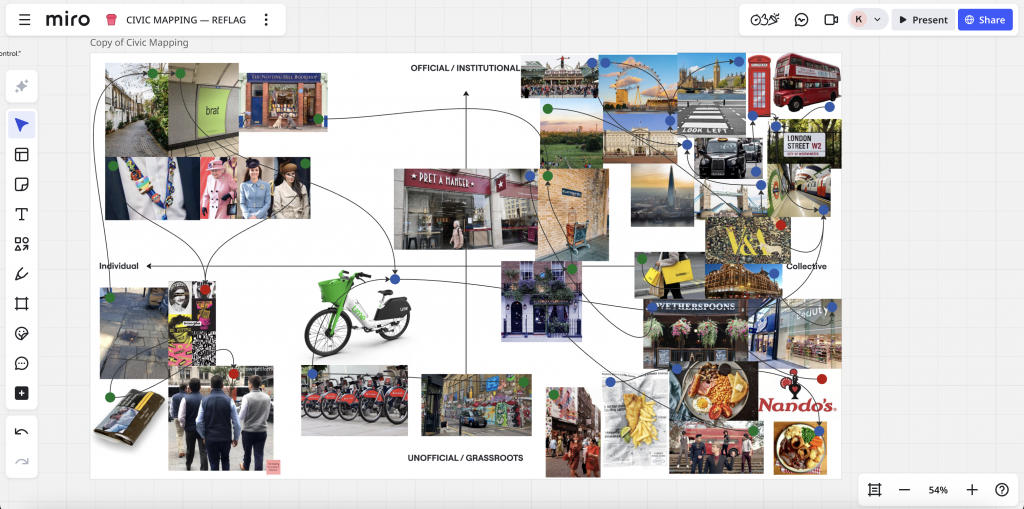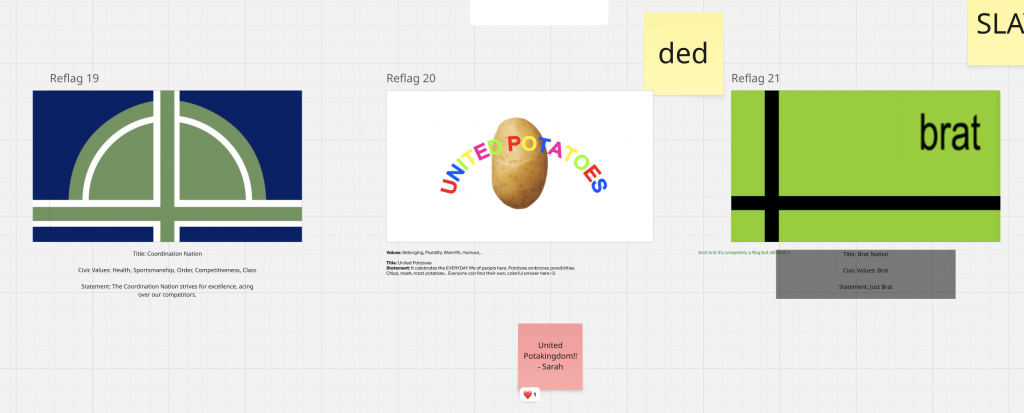This week’s session explored how identity is not a fixed essence but a positioning a way of becoming through signs, symbols, and representations. Drawing on Stuart Hall’s idea of representation and Chantal Mouffe’s notion that “every symbol of unity also marks a boundary,” the lecture questioned how design both connects and divides communities.
We discussed national identity as a designed invention a semiotic fiction made visible through flags, rituals, and myths of unity (Benedict Anderson, 1983). Examples such as Cool Britannia or the London 2012 Olympics show how branding can temporarily reimagine what “Britishness” means. Yet, these representations often simplify complex realities and raise questions about who gets to define belonging.
By contrast, civic identity is more local, lived, and negotiated. It is performed through everyday spaces and visual systems from street art and uniforms to architecture and signage. These material cultures shape how people see themselves within the city and how inclusion or exclusion operates visually.
The lecture also introduced ideas of City Branding and Symbolic Repair, showing how campaigns like London is Open use design to project inclusivity, while revealing the political tension behind such claims. Design activism was presented as a form of reclaiming the civic: using flags, logos, and public graphics not as static emblems but as open systems that invite participation and diversity.

Workshop Activity 1: Civic Mapping
In the morning, we conducted a semiotic mapping of London’s civic identity. Using an X-axis (Individual ↔ Collective) and a Y-axis (Unofficial ↔ Official), we plotted images that represent different aspects of belonging — from the London Eye and Buckingham Palace (official/collective) to street murals, Pret A Manger, and bike-sharing schemes (grassroots or everyday collective systems).
Each item was annotated as:
- Icon – direct representation (e.g. skyline, monuments)
- Index – presence or activity (e.g. signage, bikes, uniforms)
- Symbol – abstract meaning (e.g. flags, crests, mottos)
This mapping revealed how London’s civic identity emerges from both institutional symbols and everyday gestures a mix of pride, commerce, and multicultural expression.

Workshop Activity 2: Re-Flag
In the afternoon, we reimagined flags as living semiotic systems that express the plural, hybrid, and everyday nature of civic identity today. Each group designed a new “flag of belonging” inspired by their morning map.
Our group created three proposals:
- United Potatoes – my concept, celebrating the warmth, humour, and everyday diversity of life in the UK. The potato, a staple of British food culture, becomes a playful symbol of inclusivity: “Everyone can find their own, colourful answer here.”
- Coordination Nation – highlighting values of sportsmanship, order, and competitiveness.
- Brat Nation – referencing a youthful, self-expressive energy.
Through this exercise, we learned that every flag is a proposal for community, not a statement of fact. The project turned national symbols into tools of dialogue ways of questioning how belonging is designed and how humour, care, and plurality can reshape civic identity.
Reflection
This workshop helped me see design as a social language every colour, form, and word carries ideological weight. Civic symbols are not just decorative. They are performative gestures that shape how people feel seen. My United Potatoes flag uses humour and food as a common ground, turning an everyday object into a message of shared belonging.
Leave a Reply